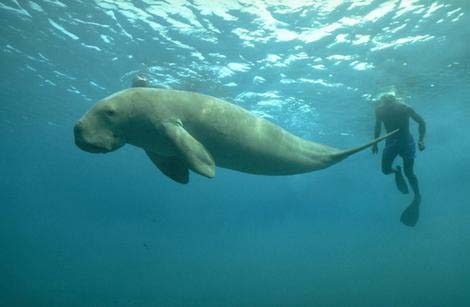
As part of Qatar’s efforts to protect marine life, a government organization has signed an agreement with ExxonMobil to help protect the vulnerable dugong.
The “sea cows” have apparently lived in and around Qatar’s waters for centuries, but not many residents are aware of their existence, an official at the Natural Reserves Private Engineering Office told Doha News.
That group signed a memorandum of understanding with ExxonMobil Research Qatar (EMRQ) this week to share research that would help protect the country’s dugong and other marine life.
The study is an expansion of research that EMRQ is undertaking with Qatar University and Texas A&M University at Galveston.
In a fall interview with Qatar Foundation about their work, EMRQ research director Dr. Jennifer Dupont said:
“In the winter, it has been reported that the dugongs tend to congregate in northwest Qatar and then they spread out around the coast during the summer. Reports and sightings are sparse, leading to less awareness about the animals among residents of Qatar. We hope that this study will increase people’s attention to the presence of these iconic animals.”
Important habitat
It is not clear exactly how many dugongs reside within Qatar’s waters, but there are around 6,000 of the sea mammals in the Gulf.
Qatar is home to at least two out of three important regional dugong habitats, according to EMRQ.

Research shows the vegetarian mammal has long served as a source of food and commerce in the Gulf.
However, it is now illegal for fishermen in most countries to hunt for its meat and oil, as dugongs are classified as “vulnerable” to extinction, according to the International Union for Conservation of Nature and Natural Resources.
The prohibition also applies in Qatar, where Law No. 19 for the year 2004 protects endangered species and those that are vulnerable to extinction.
Qatar is home to the largest population of dugongs following Australia, according to a senior official at the PEO’s Natural Reserves.
Dupont said in a statement:
“My team and I will work collaboratively with our academic research partners, along with government agencies such as the Private Engineering Office, to secure necessary resources and scientific expertise needed to ensure that these beautiful and fascinating creatures are protected and continue to live unhindered in their natural habitat.”

In January, EMRQ and the PEO conducted a one-day field mission to determine the specific location of the dugongs off the west coast of Qatar.
At the time, around 300 to 500 dugongs were spotted by researchers, mostly mothers and their babies.
Baby dugongs stay in close contact with their mothers until they’re 18 months old and sometimes the mother will gently carry them on her back to the surface to breathe.
Meet the dugong
Dugongs are mammals that are usually found in warm coastal waters. They can grow to be up to 3m long and weigh more than 400kg, according to EMRQ.

One factor that contributes to their vulnerable status is that they are slow to reproduce. The gestation period for a female dugong is one year and usually results in one calf that lives up to 70 years, according to the National Geographic.
Dugongs can stay underwater for up to six minutes before surfacing to breathe through its lungs, and sometimes breathes while “standing” on its tale and poking its head outside the water.
The mammals are related to manatees and follow them in appearance and behavior, but the dugong’s tail is flatter and similar to that of a whale’s. It also has flippers like paddles.
Dangers
Because the “sea cows” mainly subsist on a diet of sea grass, overfishing that results in the accidental collection of these plants poses a major threat to their existence.
Accidental catches have also threatened a more recent addition to Qatar’s marine life, the whale shark.
According to Nawaf Jabr Al-Nuaimi, the PEO’s Natural Reserves office manager, changes in their coastal environment and habitat degradation are also big concerns for the dugong.
In January, EMRQ said in a statement that they found 14 dugong carcasses washed up on Qatar’s shores. Months earlier, in a QF interview, Dupont alluded to the problem, saying:
“Similar to other areas around the world, coastal development in Qatar is increasing threats to marine mammals such as dugongs. Individuals may get caught in fishing nets or hit by boats, so you occasionally find dugong carcasses that wash up on the beach.”
Thoughts?
Note: This article has been updated to reflect that the Natural Reserves Private Engineering Office is not affiliated with the Ministry of Environment.







